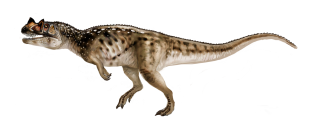Ceratosaurus nasicornis

Name: Ceratosaurus nasicornis
(Pronunciation: sir-AT-toe-SORE-us nay-si-CORN-iss)
Age: Late Jurassic (~150 million years ago)
Where It's Found in Utah: Cleveland-Lloyd Dinosaur Quarry, Emery County, and Dinosaur National Monument, Uintah County.
Geologic Formation: Morrison Formation (Brushy Basin Member)
Classification: Saurischia - Theropoda – Ceratosauria
Description: Ceratosaurus nasicornis fossils are rare but instantly recognizable. This large carnivorous dinosaur has a prominent nasal horn with two other horny bumps over both eyes. The name Ceratosaurus actually means “horned lizard.” It grew to lengths of around 25 feet (6-8 meters). Unlike most carnivorous dinosaurs, it had a row of bony armor, called osteoderms, along its back. Ceratosaurus is a much rarer fossil than its famous cousin, Allosaurus.
Why It’s a Top NHMU Dinosaur: Ceratosaurus has been found in the Morrison Formation of Utah, Colorado, Wyoming, and Oklahoma. One of the more complete skeletons of Ceratosaurus is housed at the NHMU. This specimen was found at the Cleveland-Lloyd Dinosaur Quarry. Ceratosaurus is distinctive for its horn-like crests. Paleontologists are not sure if the crests were used to attract mates, recognize other members of its species, or for some other purpose. It was an early member of a larger group called Ceratosauria which later diversified in the Cretaceous of South America and Africa, including species such as Carnotaurus and Majungasaurus. In Utah, Ceratosaurus shared its environment with other, larger predators such as Allosaurus and Torvosaurus. Paleontologists think each of these large carnivores must have had distinct roles in the ecosystem, perhaps feeding on different prey.
Where Can I See It?: The Past Worlds Gallery at the Natural History Museum of Utah; Cleveland-Lloyd Dinosaur Quarry; Dinosaur National Monument
Suggested Reading/References:
Gilmore, C. W. 1920. Osteology of the carnivorous Dinosauria in the United States National Museum, with special reference to the genera Antrodemus (Allosaurus) and Ceratosaurus. United States National Museum Bulletin 110:1-159.
Madsen, J. H., Jr., and S. P. Welles. 2000. Ceratosaurus (Dinosauria, Theropoda) a revised osteology. Utah Geological Survey Miscellaneous Publication 00-2:1-80.
Tykoski, R. S., and T. Rowe. 2004. Ceratosauria; pp. 47-70 in D. B. Weishampel, P. Dodson, and H. Osmólska (eds.), The Dinosauria, 2nd Edition. University of California Press, Berkeley.
Credits:
Image: © Victor Leshyk
Author: Joshua Lively, Paleontology Graduate Student at the Natural History Museum of Utah (2012)